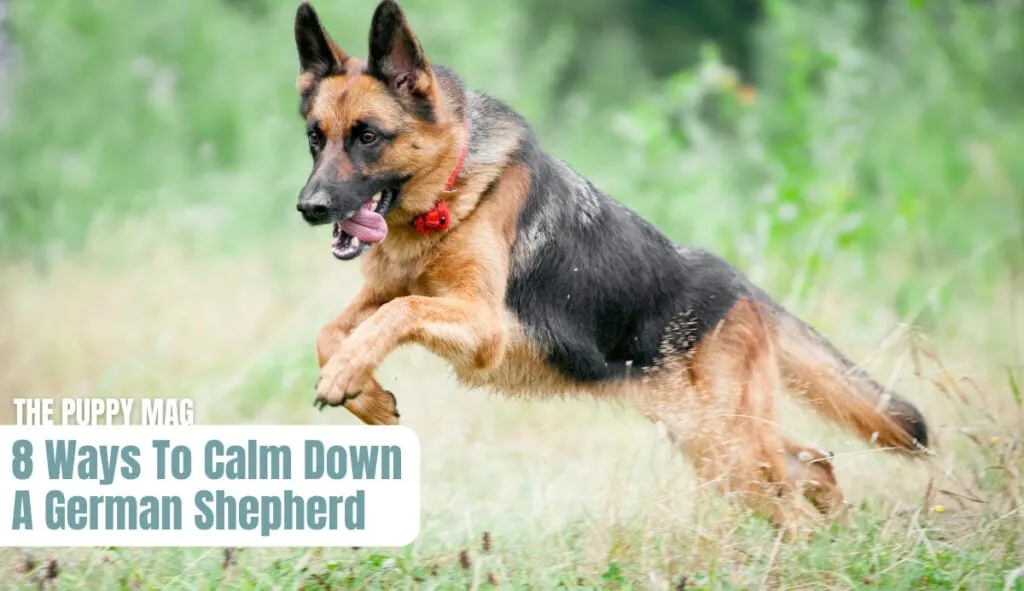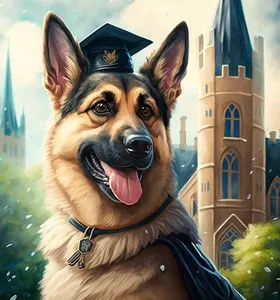So when will your GSD finally calm down? This is actually one of the most popular questions we receive from German shepherd owners! This article will explain everything you need to know on this important topic.
German shepherds calm down after 2-3 years. This is the most common age range when most German shepherds mature and calm down a little.
Still, it’s crucial to understand that age alone will not solve hyperactive behavior. Owners have to take proactive steps in managing their GSD’s energy levels regardless of their age.

Why Do German Shepherds Have So Much Energy?
How do GSDs have so much energy to begin with? To this day, German shepherds remain to be one of the top working dogs, if not the no.1 working dog!
To perform at such a high level, German shepherds have adapted to have impeccable endurance, stamina, attention, and energy levels.
Even if you have a German shepherd as a companion pet, it’s still in their genetics to have a huge capacity for exercise and activity as this is what they’re used to.
Assuming joint health is good, many GSD owners I’ve spoken to say their 10+ year old German shepherd still has the desire to be outside exercising for many hours every day.
When Will My German Shepherd Puppy Calm Down?
I personally noticed a change in hyperactivity and energy level after 3 years with my GSD. I’ve also heard the same from several other GSD owners.
It’s usually the females that calm down a little before the males, but each case is different.
While 2-3 years is the most common age range that owners may notice a difference in energy levels, it’s crucial to understand that age alone is not the answer to dealing with a hyper GSD.
The best way to get a calm German shepherd is to manage their energy levels appropriately.
If a German shepherd is not sufficiently stimulated (physically, mentally, socially) then it doesn’t matter what age they are, hyperactivity and other negative behavior will likely be the result.

Psst. A quick word on Training! Brain Training For Dogs could be the best training approach we’ve seen for GSD puppies. Results show improvement in obedience and behavior quicker than we thought possible! Definitely check it out.
8 Ways To Calm Down Any German Shepherd
Let’s run through the best ways that you can help your GSD calm down a smudge. If these tips are implemented you’ll see a noticeable difference in no time at all!
1. Stick to a routine
The power of routine and sticking to set times is not spoken about enough! Dogs, especially highly intelligent breeds like German shepherds, absolutely need daily routines.
Having set times for everything will instantly reduce stress, anxiety, and can even improve obedience.
Eating, exercising, training, playing, socializing, and even brushing, should ideally be around the same time every day.
Your German shepherd will learn to expect these activities at certain times, allowing them to remain calm during all other times. Not knowing what’s going on, is very frustrating for intelligent and alert dogs.
2. Exercise twice per day and first thing in the morning
Although most owners exercise their German shepherd once per day, exercising them twice per day is extremely beneficial.
Along with exercising twice per day, exercising your GSD first thing in the morning is a game-changer. When your GSD wakes up, they’ll be full of pent-up energy and raring to go… It’s crucial we expend some of that energy to set them up for a calm and collective day ahead.
German shepherd adults (over 1 year) should ideally receive 90-120 minutes of exercise per day. Split this up into two sessions, once in the morning and another in the evening.
German shepherd puppies, (under 1 year) should stick to a set puppy exercise routine to ensure their joints and bones can develop properly before receiving too much stress.
Important read: German shepherd hip dysplasia information
3. Increase socialization activities
Socialization is a hugeee one. Perhaps the most potent form of mental stimulation comes when two dogs sniff, play, and interact with each other.
In most cases, socialization and mental stimulation are not focused on enough in daily routines. It’s this, however, that truly tires out a highly intelligent dog like German shepherds.
To increase socialization, you can stay longer at the dog park, visit doggy play groups, find Facebook groups online in your local area for the purpose of dog socialization, or visit friends that have dogs more often.
Increasing socialization will improve your German shepherd’s friendliness, behavior, and happiness, and will drain their energy quicker than anything else.
4. Use puppy pens for cool down periods
Puppy pens are an excellent tool when used correctly. Not only will they keep your puppy safe and contained, but they can act as a place where your puppy learns to calm down.
Puppy pens are essentially like crates, but far more liberating and comfortable. By placing your pup in the pen, it will limit their movement and encourage them to calm down. Of course, it’s important to put them in there with a nice chew stick or their favorite toy.
Important note: It’s CRUCIAL that your puppy sees the puppy pen as a happy and fun place to be. If your pup considers the puppy pen as a punishment, it will not work to calm them down.
Spend a week or so building positive associations with the pen. This means spending time with your pup around the pen, throw toys in there, treats, and give plenty of praise.
As long as your puppy enjoys being in the pen, then this will work wonders for whenever you need your pup to calm down quickly.
Of course, it’s not recommended to leave your puppy in the pen for hours on end. This is designed to be a quick and temporary “cool down period”.
Related: Why are German shepherds so dramatic
5. Puzzle toys
Puzzle toys, or otherwise known as “interactive toys” are great for providing mental stimulation and keeping dogs occupied.
Puzzle toys usually require your pup to figure out a simple (or hard) challenge in order to receive the treat.
Some puzzle toys are better suited for when you are there to assist, and others are set-and-forget, perfect for when you leave the house.
As explained before, providing more mental stimulation for your German shepherd will without a doubt reduce their energy and hyperactivity.
Our favorite set and forget toy: Star Mark Bob a Lot
Our favorite puzzle toy that requires assistance: Nina Ottosson
6. Keep up with daily command training!
Of course, any German shepherd owner knows just how important training is… But still, I speak to so many owners who stop command training way too early!
It won’t take long before your GSD learns all the basics like sit, stay, down, paw, come, and drop… But that doesn’t mean we should stop training them.
With a little creativity you can make each training session different and more complex. And even if you can’t it’s still important to run through those basics.
By doing this you’ll be providing your GSD with valuable mental stimulation, giving them something to do, satisfying their desire to appease their owner, and most importantly, expending their energy!
Try to incorporate 30-45 minutes of dedicated command training on a daily basis (ideally at the same time!).
If you’re already doing this, that’s awesome and keep it up!
Popular read: When Do German Shepherd Ears Stand Up?
7. Avoid leaving your German shepherd home alone too long
German shepherds are not a breed that’s comfortable being left alone for too long.
While we can’t always be with our dogs, it’s important to limit the time they are alone. This will keep their stress and anxiety levels down, prevent bad behavior and reduce the chances of hyperactive behavior.
All GSDs are different, but as a general rule of thumb, we shouldn’t be leaving them alone for more than 4-5 hours at a time (and for puppies, even less!)
If you are leaving your GSD home alone for a few hours per day, then ensure they have had some exercise before, and provide them with a puzzle toy, or training prior to leaving them.
8. Spend more time with your GSD
Along with the tips above, it’s a great idea to simply spend more time interacting with your GSD.
Over the years, I’ve found in many cases that hyperactive behavior can be triggered by not receiving enough of their owners attention.
This could certainly be the case for German shepherds too, considering just how much they crave their owners attention and time.
If a German shepherd starts to feel alone, understimulated, or disengaged, then many unwanted behaviors can be the result (hyperactivity being just one of them).
Recommended: Mental Stimulation For German Shepherds: (8 Best Ways)
So Why Do These Tips Work?
The 8 tips above all work to help keep your German shepherd calm because they are all stimulating and engaging.
Working dogs like German shepherds absolutely need to be stimulated physically, mentally, and socially. The tips above accomplish this in one way or another.
By adjusting your GSDs daily routine to include these tips, not only will their hyperactivity reduce, but their overall behavior, happiness and stress levels will improve.
Prioritise what your German shepherd needs when they need it, and their behavior and temperament will be exemplary.
German Shepherds Are Energetic Dogs!
This last section is just a reminder that German shepherds are energetic dogs after all!
There is only a certain amount of “calming down” we can expect from a young German shepherd.
These dogs are not couch potatoes, and will have energy way into their senior years.
As long as we raise a friendly, obedient, and happy German shepherd, their energy levels will be manageable with fairly little effort.
Thank you for reading! If you have any questions please message in! For now, check out more German shepherd articles
Extra resources:
GoodRX Calming Down a Hyper Dog
PETMD Calming Hyperactive Dogs
